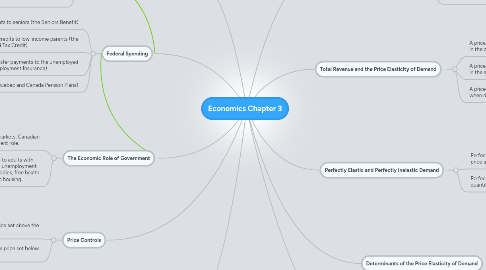Economics Chapter 3
by Nik Ivanov

1. Perfectly Elastic and Perfectly Inelastic Supply
1.1. Perfectly elastic supply means constant price and a horizontal supply curve
1.2. Perfectly inelastic supply means constant quantity supplied and a vertical supply curve
2. Price Controls
2.1. A price floor is a minimum price set above the equilibrium price
2.2. A price ceiling is a maximum price set below the equilibrium price
3. The Economic Role of Government
3.1. Besides intervening in private markets, Canadian governments have an independent role.
3.2. Government programs include payments to adults with children, retirement funds for the elderly, unemployment insurance, welfare, higher education subsidies, free health care and schooling, and subsidized public housing.
4. Federal Spending
4.1. Transfer payments to seniors (the Seniors Benefit)
4.2. Tax credits to low-income parents (the Child Tax Credit)
4.3. Transfer payments to the unemployed (Employment Insurance)
4.4. Pensions (the Quebec and Canada Pension Plans)
5. Provincial and Territorial Spending
5.1. The responsibilities of provincial and territorial governments include:
5.1.1. health care
5.1.2. subsidies for post-secondary education
5.1.3. welfare services
5.2. The federal government pays a portion of these costs through the Canada Health and Social Transfer (CHST).
6. Elastic and Inelastic Demand
6.1. Price elasticity of demand shows how responsive consumers are to price changes
6.2. Elastic demand means % change in quantity demanded is more than % change in price
6.3. inelastic demand means % change in quantity demanded is less than % change in price
6.4. Unit-elastic demand means % change in quantity demand equals % change in price
7. Perfectly Elastic and Perfectly Inelastic Demand
7.1. Perfectly elastic demand means constant price and a horizontal demand curve
7.2. Perfectly inelastic demand means constant quantity demanded and a vertical demand curve
8. Total Revenue and the Price Elasticity of Demand
8.1. A price change causes total revenue to change in the opposite direction when demand is elastic
8.2. A price change causes total revenue to change in the same direction when demand is inelastic
8.3. A price change does not affect total revenue when demand is unit-elastic
9. Determinants of the Price Elasticity of Demand
9.1. Portion of consumer incomes (products with smaller portions more inelastic)
9.2. Access to substitutes (products with more substitutes more elastic)
9.3. Necessities versus luxuries (more inelastic for necessities and more elastic for luxuries)
9.4. Time (more elastic with the passage of time)
10. Elastic and Inelastic Supply
10.1. Price elasticity of supply measures the responsiveness of quantity supplied to price changes
10.2. Elastic supply means % change in quantity supplied is more than % change in price
10.3. Inelastic supply means % change in quantity supplied is less than % change in price


